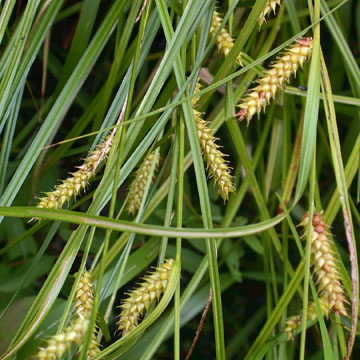

Carex vesicaria - (image 1 of 4)
Taxonomy
Family: Cyperaceae
Section Vesicariae
Habitat
Wet soil or shallow water of bogs, swamps, or margins of ponds or streams.
Associates
Distribution
Circumboreal, south in North America to DE, KY, IN, MO, and CA.
Morphology
Loosely to densely cespitose on short, stout, branching rhizomes; stems 30-100 cm, sharply trigonous, scabrous above; basal sheaths reddish brown to reddish purple, not spongy; leaves elongate, flat, 3-8 mm wide; spikes several, sessile or very short-pedunculate, erect or the lower ones ascending, remote, the lower pistillate, the upper staminate, or one of them androgynous; staminate spikes 2-7 cm; pistillate spikes 2-7 cm long and 1-1.5(-2) cm thick at maturity; pistillate scales a bit shorter and narrower than the perigynia, thin, acute to acuminate, awnless; perigynia crowded, ascending, in 6(-8) vertical rows, 5-8 mm long and 2-3 mm wide, strongly 10-20-nerved, lanceolate or lance-ovate in outline, inflated below, gradually tapering to a flatter beak 1.1-2.6 mm with straight teeth 0.3-0.9 mm; achene symmetrical, yellowish, trigonous, 1.7-2.4 mm, loose in the lower part of the perigynium, continuous with the bony, flexuous to strongly contorted style.
Notes
Fruiting June to August
Wetland indicator: OBL
Similar to C. tuckermanii but the perigynia smaller (about 3 mm wide vs. 4+ mm wide) and the achene not indented on one angle. See also notes for C. utriculata.
References
Ball, P.W. and A.A. Reznicek. 2002. Carex, In: Flora of North America Editorial Committee, Eds. Flora of North America North of Mexico. Volume 23. Oxford University Press, New York.
Gleason, Henry A. and A. Cronquist. 1991. Manual of Vascular Plants of
Northeastern United States and Adjacent Canada. Second Ed.
The New York Botanical Garden. Bronx, NY
|
© Michael Hough 2018 |